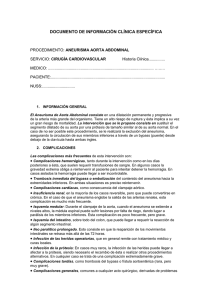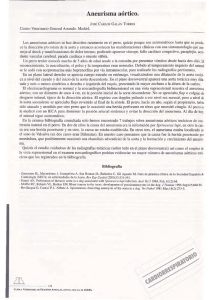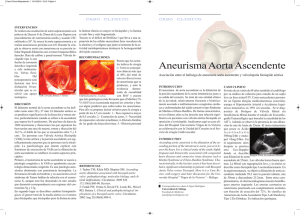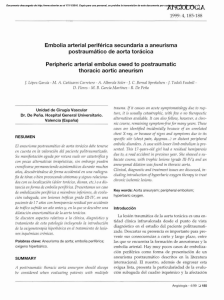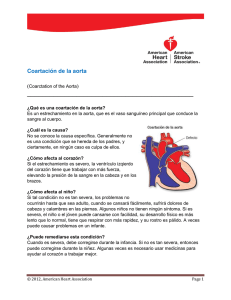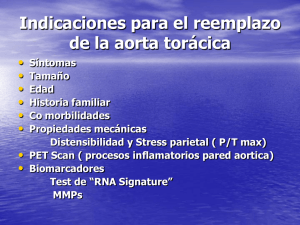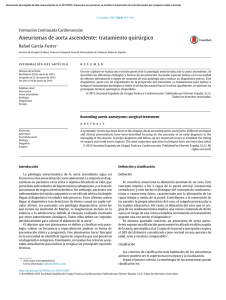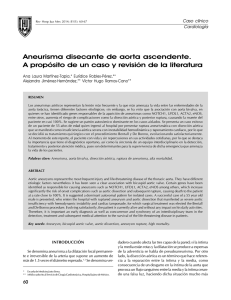aneurisma de la aorta toracica
Anuncio
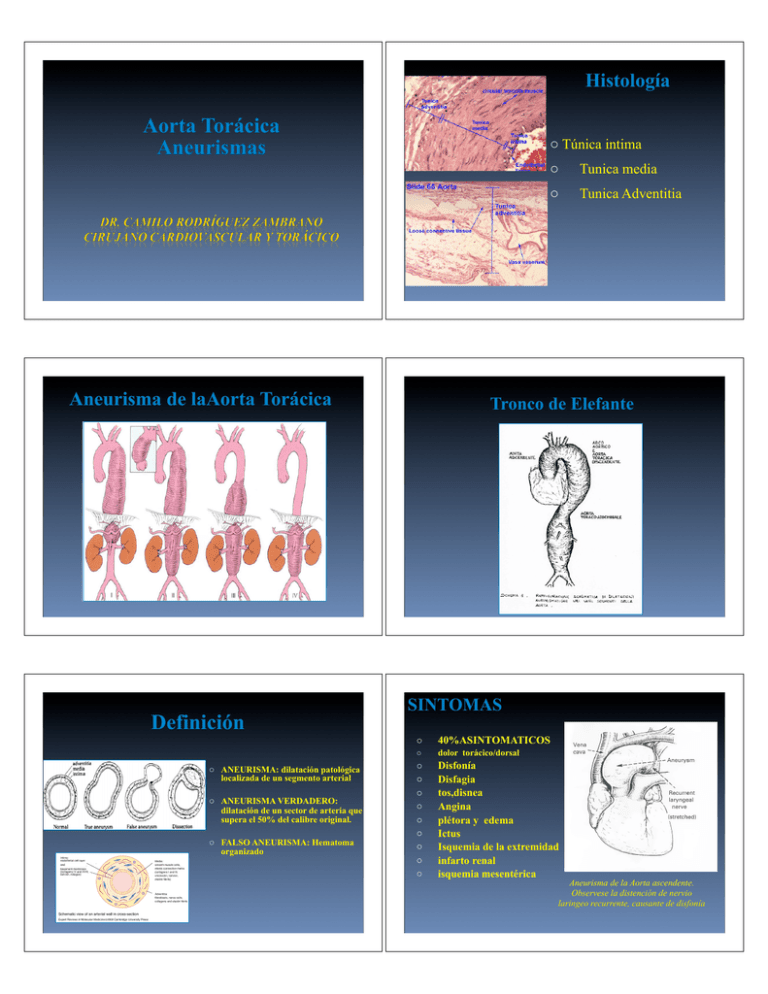
Histología Aorta Torácica Aneurismas o Túnica intima Aneurisma de laAorta Torácica Definición o ANEURISMA: dilatación patológica localizada de un segmento arterial o ANEURISMA VERDADERO: dilatación de un sector de arteria que supera el 50% del calibre original. o FALSO ANEURISMA: Hematoma organizado o Tunica media o Tunica Adventitia Tronco de Elefante SINTOMAS o 40%ASINTOMATICOS o dolor torácico/dorsal o o o o o o o o o Disfonía Disfagia tos,disnea Angina plétora y edema Ictus Isquemia de la extremidad infarto renal isquemia mesentérica Aneurisma de la Aorta ascendente. Observese la distención de nervio laringeo recurrente, causante de disfonía ETIOLOGIA ! Ateroscleróstica ! Desorden del tejido conetivo o necrosis quística de la media (Sínd. Marfan,Sínd. Ehlers-Danlos) ! Enf. infiamatorias (granulomatosis ,arteritis de células gigantes, arteritis de Takayasu) Sífilis Disección de la aorta Trauma Aórtico Infecciosas ! ! ! ! DIAGNOSTICA POR IMAGENES o o o o o o SIGNOS ! Soplo de insuficiencia aórtico ! Presión diferencial elevada ! Deviación de la tráquea ! Soplo paravertebral Izq. Aneurisma de la Aorta Asc. Con dilatación del añillo valvular.. RX TORAX RX Tórax TAC Aortografia Angio-Resonancia Ecocardiografía transtorácica Ecocardiografía transesofágica TOMOGRAFIA COMPUTADA Aneurisma de la Aorta Aneu. Aorta Descendente con trombo mural . A nivel del la Aurícula Izq. aneurisma Trombo mural ECOCARDIOGRAFIA TRANSTORACICO Ecocardiografía Transesofágica There is gross dilatation of the ascending aorta, with loss of the sinotubular junction (note the 1 cm markers on the left side of the sector). Aortograma oSensitivo y específico oInvasivo oConsume tiempo oIntraoperatorio de ser necesario Marked dilatation of the ascending aorta has resulted in functional aortic regurgitation. There is limited opening and closing of the AV because the leaflets are suspended from the markedly dilated sinotubular junction. A large diastolic coaptation defect of the AV is apparent. Colour flow Doppler imaging confirms the presence of severe aortic regurgitation (jet width > 40% of outflow tract width). Incidencia o 400/100000 (>65años) o 670/100000 (>80 años) Rotos o 20/100000(>65 años) o 100/100000(>80 años) RUPTURA TRATAMIENTO Médico BETA-BLOQUEADORES " QUIRURGICO Remplazo de la Aorta Endovascular Indicaciones para la Cirugía o Sintomático o 5.0-6.0 cm en Aorta Ascendente o 5.5-6.0 cm en el Arco Aórtico o 5.0-6.0 cm en la Aorta Descendente o Si durante el reemplazo de una Válvula Aórtica con-existen una válvula bicúspide o insuficiente, la aorta asc. Debe ser reemplazada cuando el diámetro es de 4.5cm o mayor. o Marfans >5.0-5.5cm o Crecimiento anual > 1 cm VIAS DE ACCESO TRATAMIENTO QUIRURGICO La Aorta Ascendente y la Válvula Aótica " Toracotomía postero lateral izquierda. " Toraco freno Laparotomía o Reemplazo de Ao. Ascendente o Reemplazo de Ao. Ascendente + valvular • CIRUGIA DE LA AORTA ASCENDENTE Y DEL ARCO AORTICO REEMPLAZO DE LA AORTA ASCENDENTE REEMPLAZO DE LOS TRONCOS SUPRAOARTICOS COMPLICACIONES o o o o o Daño cerebral Paresia y paraplegia Insuficiencia renal Disfun pulmiónonar Reintervención Protective mechanism of brain during HCA PROTECCION CEREBRAL DURANTE CIRUGIA DEL ARCO AORTICO o HIPOTERMIA PROFUNDA CON ARRESTO CIRCULATORIO TOTAL • Exact mechanism – unknown – Major effect • hypothermic metabolic suppression Safe Duration of HCA • Temp • (°C) • 37 o PERFUSION CEREBRAL RETROGRADA Cerebral Metabolic Rate (% of baseline) 100 Safe Duration of HCA (min) 5 • 30 56 (52-60) • 25 37 (33-42) • 20 24 (21-29) • 15 16 (13-20) • 10 11 (8-14) • Q10 : 2.3 (to 15 °C; 2.05, 15-11.4 °C; 3.5) o PERFUSION CEREBRAL SELECTIVA o (SCP)ANTEROGRADA SEGUN KAZUI Protección Hipotérmica 9 (8-10) 14 (12-15) 21 (17-24) 31 (25-38) 45 (36-62) (Ann Thorac Surg 1999;67:1895-9) ARRESTO CIRCULATORIO TOTAL o" en O2 demanda, ! en la tolerancia isquemica Tiempo límite de securidad (TEORICO) oEl grado de protección no es proporcional a la tasa de reducción metabólica 30 MIN A 15°C MC CULLOUGH: Annals Thoracic Surgery 1999; 54:609-16 JUGULAR VENOUS OXIMETRY CMRO2 CMRO2 = (cosumo cerebral de O2) SBJVO2 CBF X a-vjDO2 Irrigación de la Medula Espinal Arterias Radiculares o 75% : AEA o 25% : AEP viene de la ACI o AEA viene de las Arterias: oRadicular oIntercostal o Lumbar o Basilar oVertebral oCervical oIliaca La Arteria de Adamkiewicz • 6 # 10 A. radicular ant. • T3 # T7 – Usualmente una Art. radicular – pobre fluido aferente Sitios de origen de la Arteria Espinal Anterior o Art. Radicular anterior o Desde T7 # L1 o Mayor que otras o Perfunde la medula espinal distal o Es de pequeño calibre por arriba de los miembros sup. o Basado en este hallazgo, es recomendable, siempre que sea posible, a todos los ramos intercostales y lumbares desde T6 hasta L1 , deben ser re-anastomosadas. (Lars G. Svensson, 1998) Drenaje de líquido céfalo raquídeo A) During ACC, distal Ao. Pr. decreases markedly, causing a reduction in spinal a. perfusion Pr. and a subsequent increase in CSF Pr. B) LA to LtFA bypass, or distal aortic perfusion, increases distal Ao. Pr. leading to an increase in the spinal a. perfusion Pr., thus increasing blood flow to the spinal cord. The addition of CSFD further decreases CSF Pr. and augments the perfusion of the spinal cord. Moderate hypothermia (32°C) provides additional spinal cord protection. (Safi, et al.) CPB (with hypothermic TCA) Gott shunt o Kouchoukos et al : 9.8% early mortality, 6.5% cord injury o Crawford et al : paraplegia in 2/25 due to unable to anastomose critical intercostal aa o Distal perfusion pr > 60 mmHg An approach to spinal cord protection during descending or thoracoabdominal aortic repairs Lars G Svensson (ATS 1999;67:1935-6) • LA fem bypass • systemic hypothermia (29 - 30 º C) • CSF drainage • IT papaverine • Various topical and local cooling techniques • Reattachment of intercostals btw T6 - L2 Unfortunately, there are no prospective randomized studies showing that any one method is significantly effective, but it is likely that a combination of various techniques and agents reduces the risk of this dreaded complication By Lars G. Svensson Pronóstico Causa de Muerte 100,000 " PRECOZ Aneu. Ao. Ascendente Survival(%) 79,375 Aneu. A rco Aór tico Aneu. A o. Desce nden Aneu 58,750 te/Torác . Ao. Torac o ica Abdo mina l 38,125 17,500 0 2,5 5,0 Years after surgery 7,5 10,0 -Infarto miocardico -Falla cardíaca -Hemorragia -Disfunción Neurológica " TARDIA - Falla cardíaco -Ruptura de un nuevo Aneurisma -Insuficiencia renal -Insuficiencia respiratoria ENDOPROTESIS
